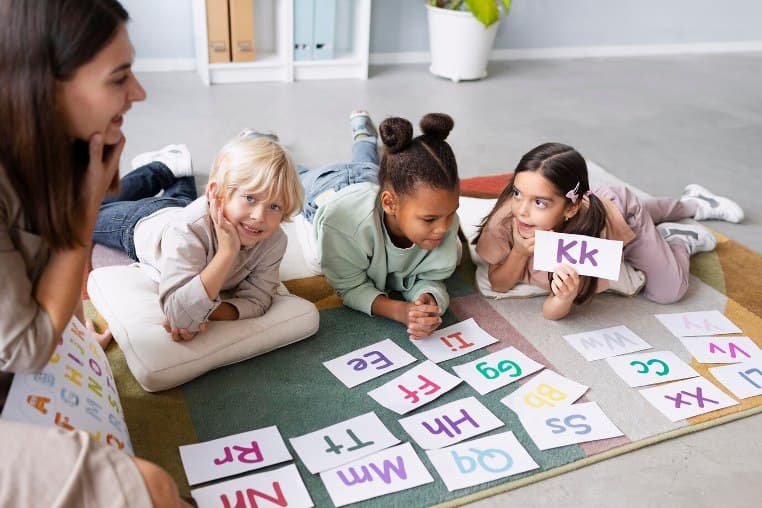A classroom teacher is responsible for teaching the curriculum and managing and interacting with an entire class. Conversely, intervention teachers conduct small groups or one-on-one sessions to help students struggling with specific subjects or topics.
Classroom teachers and intervention teachers both play integral roles in the education system. The primary focus of these teachers is to help students succeed in the education sector and build a successful career ahead. However, there are quite a few differences between a classroom teacher and an intervention teacher.
In this guide, we will have a detailed discussion about the differences between these two types of educational personalities. We will also talk about a few essential pieces of information. So, stay tuned till the end of the guide!
Table: Intervention Teacher Vs Classroom Teacher
Before we get into details, let’s look into the core responsibilities of intervention teacher and classroom teacher!
| Intervention Teacher | Classroom teacher |
| Expertise in teaching a particular area or subject | Expertise in teaching the entire curriculum of an education level |
| Teaches in small groups | Manages a large group of students |
| Works with special assessments and instructions | Consisting and deploying social skills |
| Teaches for a limited timeframe | Teaches for an extended period |
What is an Intervention Teacher?
An intervention teacher is an educational body that specializes in teaching or working with small groups of students. They typically provide one-on-one instruction to students who require additional help or attention in a particular subject or skill.

Image Source: Freepik
Intervention teachers are known for their work with students who struggle in particular areas, such as reading, writing, or math. They also help students with special needs or learning disabilities.
The main focus of an intervention teacher is to provide help and ensure that the student catches up with the rest of their class.
Roles Of An Intervention Teacher
Being an intervention teacher is a big responsibility. And there are several things that you need to take care of. Let us look at the roles and responsibilities of an intervention teacher.
Expertise in teaching a particular area or subject
Intervention teachers typically have expertise in a particular field of study or skill. This includes math, reading, writing, speaking, and so on. The teachers utilize their expertise to help students battling with these areas of education.
Teach in small groups
Intervention teachers usually teach students in small groups or provide one-on-one instructions. This helps to ensure that the person receives the extra attention or help they require. Not only that, but it also allows the teaching body to focus on the problems of the student.
Special assessments & instructions
The intervention educators rely on special assessments and instructions, which help them to track the progress and condition of the students. Additionally, they also use specific techniques for teaching and alter them accordingly for the betterment of their students.
Timeframe
As mentioned earlier, intervention teachers work with students with special needs. They typically teach students who are weak in specific skills or subjects.
However, the teaching timeframe of an intervention educator usually ranges from 3 to 6 months. Not only that, but the timeframe also varies depending on the requirements and conditions of the student and their progress.
What Is A Classroom Teacher?
A classroom teacher is known to be the primary class instructor. They are typically responsible for teaching the curriculum and managing the classroom. This includes planning and delivering lessons, assessing student progress, and communicating with parents and other teachers about student progress.

Image credit: Freepik
The primary responsibility of a classroom teacher is to deliver and teach the curriculum while creating a safe learning environment for all students. They teach the curriculum for the entire school year and often report to the administration of the school or educational institute.
Roles Of A Classroom Teacher
Similar to intervention teachers, classroom teachers also have particular responsibilities toward their students. Check out the responsibilities and roles of a classroom teacher as follows.
Expertise in teaching the curriculum
Classroom teachers are usually experienced in teaching the curriculum to the students in their class. They are typically responsible for educating children according to the standards and guidelines of the institute and district.
Related: Types of Preschool Curriculum for Toddlers and Kids
Manage the classroom
One of the biggest roles of a classroom teacher is to manage the class properly. This is because each class consists of about 30 to 40 students, and managing them can often be challenging.
Teachers use several techniques and methods to control and discipline the class while ensuring a comfortable learning atmosphere.
Creativity & strong communication skills
Classroom teachers must use several creative ways and methods to teach the curriculum to the students. This helps to ensure that the students can properly focus in class. Teachers must also have strong communication skills to communicate with the students without any trouble and help them properly.
Learn before teaching
One of the responsibilities of a classroom teacher includes learning before teaching the class. This is important to make sure that you adapt the curriculum and the new changes to ensure better understanding and education of the students.
Timeframe
Classroom teachers teach a class for a year. Moreover, the educators will teach the entire curriculum, take exams, and report the progress of students to the respective authorities.
Not only that, but the teachers also alter their curriculum according to the progress to ensure that the syllabus is completed on time.
Differences Between Intervention Teachers Vs Classroom Teachers
There are quite a few noticeable differences between an intervention teacher and a classroom teacher. These variations include the number of students, timeframe, curriculum, and many more. Take a look at the differences between these two teacher categories.
1. Responsibility
One of the major differences between an intervention teacher and a classroom teacher is their responsibility. The intervention educator has to pay attention to a small group of students, while a classroom teacher has to teach and manage an entire class.
2. Curriculum
Classroom teachers have to teach students the entire curriculum from start to finish. And this syllabus must be prepared according to the guidelines of the state education department and school policies. Conversely, intervention teachers only help students in particular fields of education or skills.
3. Timeframe
The teaching timeframe of both of these teachers is quite different as well. Class teachers must complete the curriculum and teach the students for the entire school year.
However, intervention educators help students overcome any problem or struggle they encounter for a short period. This period typically ranges from 3 to 6 months or more, depending on the progress of the student.
4. Instructions
Another major difference between these two teaching bodies is the instructions they provide. An intervention teacher uses their expertise and alters the instructions to meet the needs of the students.
However, the class teachers follow a wide range of instructions to engage the students. They also make sure to provide a proper learning space for the kids.
5. Assessment Methods
There is often a huge difference noticed between the assessment methods of classroom teachers and intervention teachers. Intervention educators rely on a wide array of methods and techniques to assess the condition and progress of their students. The teachers also change their methods depending on the condition and situation of the student.
On the other hand, classroom teachers use a few methods to assess the progress of the kids. They match the progress with their curriculum and make changes if deemed necessary.
6. Reporting
Last but not least, there is a difference in reporting done by the two educators. Classroom teachers typically report to the administration office and authorities of the school.
However, intervention educators usually provide their report to a particular program or department head of the institute.
FAQs
Still got any questions about the topic? Read the frequently asked questions we have brought together for you!
Will An Intervention Teacher Also Be A Classroom Teacher?
Yes. Intervention and classroom teachers often work together to provide students with the best possible education.
How Long Does An Intervention Teacher Work With A Student?
The length of time that an intervention teacher works with a student can vary depending on the student’s needs. Some intervention teachers may work with students for a specific period, such as a semester or a school year.
Do Intervention Teachers Work With Students With Special Needs?
Yes, they use specialized instructional methods or materials that are altered according to the needs of individual students.
Final Words
Intervention teachers and classroom teachers both play critical roles in the educational system. Intervention instructors can also aid students who are struggling with a specific subject or ability and want extra assistance.
Classroom instructors, on the other hand, are in charge of delivering the curriculum and ensuring a secure and loving learning environment for all pupils. To satisfy the needs of pupils, a mix of intervention and classroom instruction is the ideal method.



